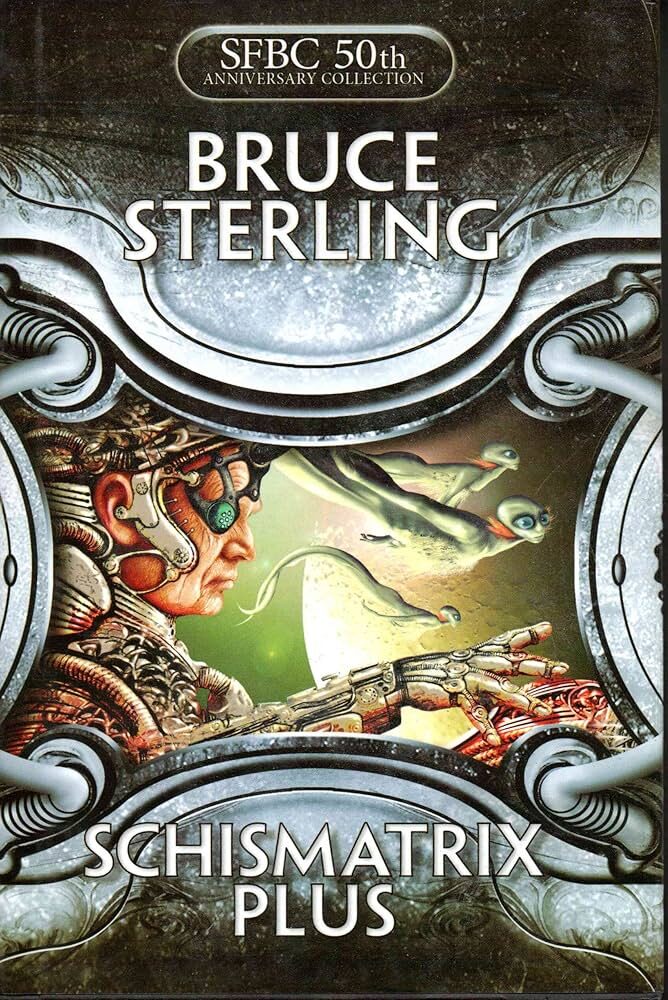Attempting to Survive Evolution – Schismatrix

Schismatrix by Bruce Sterling is a strange book. It follows Abelard Malcolm Tyler Lindsay as he travels the solar system, getting caught up in all sorts of wacky adventures with strange people, aliens, and even post-humans. In our episodes on Schismatrix, I was given the challenge of trying to summarize this book to my co-host who had not read it. We became distracted by the sheer alienness of the text and failed to fully engage with some of Sterling’s deeper themes. I want to correct that mistake here. At it’s core, Schismatrix is a story about the psychological impact of survival in the face of evolutionary pressures.
The book opens with Abelard Lindsay lamenting the status quo. He is a young man forced to live in a system dominated by an extremely elderly ruling class. With the aid of shaper biological treatments, mechanist cybernetic enhancement, or any combination of the two, people are living well into their hundreds. The concerns of the young are brushed aside by an aging minority. Lindsay, who is a shaper-trained youth in a mechanist-aligned colony, is especially alienated. He believes that these age-defying enhancements have dehumanized society. Paradoxically, Lindsay finds comfort in looking backwards to the cultures of old Earth. He believes that the people who lived long ago, before space travel and artificial life extension, were more “alive” than the old men who rule his society today. This belief leads to Lindsay establishing a Preservationist subculture that favors the Shapers and seeks to rebel against the established order.
Working with Lindsay are his two friends Vera and Constantine. Constantine is a biologist who has also received Shaper training. Constantine is currently employed by the colony to find a remedy for a blight that is impacting its biosphere. Space colonies must maintain a tight control on their ecosystems, down to the level of the microbes that inhabit the digestive tracts of its citizens. This is a subtle, but ever present, theme throughout the book. Microbial life evolves quickly and the ability of these closed systems to adapt to new organisms is almost nonexistent. The fungal blights that impact the lunar colonies, and the need to sterilize and reseed human microbiomes when moving between colonies, are not just sci-fi details that makes the book seem more realistic. They are a constant reminder of evolutionary pressure.
Lindsay and Vera decide that the ultimate rebellion in an immortality-obsessed society is suicide. They plan to kill themselves as an act of political protest. They form a suicide pact. Only when Vera dies, Lindsay is not ready to follow through. When faced with the choice between a politically significant last stand, Lindsay will choose survival time and time again. Lindsay’s defining characteristic becomes his adaptability. He becomes a conman, a mercenary, a cultural ambassador, a fugitive, a scientist, and whatever else he needs to be to survive. For the majority of the story, Lindsay is a man of intense creativity and energy. Never hesitating to uproot or reinvent himself in the name of survival.
Schismatrix is filled with some of the strangest characters, scenarios, and environments in all of science fiction. To name a few of the many disorienting concepts, there are: The Geisha Bank, The Black Medicalists, sundog mercenaries who brew their own ketamine and have organized themselves into a sovereign republic, actual aliens, organic habitats inflated in hollowed out asteroids, a woman who turns herself into a city-sized flesh monstrosity, and more. These oddities are interesting in their own right, but they also serve a practical story telling purpose. Lindsay must constantly incorporate these strange new environments and concepts into his paradigm and determine how best to thrive within them. It can be exhausting to read through them, and so the reader can only imagine how much energy it must take to live through them.
Like many organisms, Lindsay’s adaptability begins to wane when he finds a mate. He has had romantic partners in the past, but none that truly became his family. That is, not until he meets Nora. He has a family with Nora and establishes a home. They both become well established figures in Shaper society. Together, they build a legacy. At this point in the story, Lindsay is in his 60’s. He is beginning to show real signs of age and must decide whether he wants to seek a rejuvenation treatment to artificially extend his life. This is a decision that Lindsay puts off. He claims that his hesitation is related to his previous outlaw status. That he doesn’t want a geneticist to determine who he really is and ruin what he has. This seems like a shallow excuse, as many characters point out that Lindsay is rich enough to afford discretion. At least part of Lindsay must be struggling to come to terms with abandoning the ideals of his youth. Refusing to die is one thing, but artificially extending his life would be the ultimate betrayal of his younger self. He would become one of those hypocritical old men. Once again Lindsay adapts.
Lindsay gets the treatment, but this winds up setting off a series of events that threatens Lindsay and Nora’s legacy. Lindsay is once again faced with a choice. Does he stay with Nora and protect their legacy, or does he survive? He survives.
He flees alone and establishes himself in the Czarina Cluster. But this time is different. Lindsay never really recovers from abandoning Nora. He tells himself that he will get her out of that situation. That they will be together again. He survived, but this time, he did not adapt. He cannot change into a person who doesn’t love Nora. When Nora is killed by Constantine, Lindsay abandons survival. His identity has solidified. He can no longer adapt to any circumstance. He can no longer live in a universe in which the man who murdered his wife also lives. He challenges Constantine to a duel.
The duel between Constantine and Lindsay takes place in an alien simulation. Both participants will inhabit the bodies of alien entities and fight to the death. It will be a test of their adaptability and their creativity. Lindsay takes a drug that will infinitely expand his consciousness, and destroy it in the process. He wins his duel and is prepared to embrace oblivion.
Lindsay comes back to himself several years later. Old colleagues and friends have found a treatment to restore him to sanity. He has survived once again, but now he is spiritually lost. He no longer has boundless energy and creativity. He is tired. While trying to figure out his next move, Lindsay encounters a child. The child dreams of terraforming a new planet. He dreams of creating a whole new world for life to thrive on. The child believes that there can be no higher aspiration than to fill the universe with more life. Lindsay decides this child’s dream will be his new mission, since he no longer has one of his own. He takes the child and they go off to research terraforming.
The years pass and Lindsay falls into the roll of an eccentric professor. He is no longer the hero of this journey. He has become the Jungian archetype of the wise old man. In a quick scene that drips with significance, Lindsay is gifted a rat. The rat is the first mammal to ever achieve true immortality, but Lindsay is informed that the rat’s intelligence suffered as a result. It no longer shows any interest in it’s environment. Lindsay says that the rat simply needs a new environment. He lets it out of its cage and takes it with him in his pocket and the rat begins interacting with the world again. To survive, one must keep moving.
Lindsay is instrumental in terraforming Europa. He commits a great taboo by traveling to Earth to acquire the necessary biodiversity samples to finish the Europa project. His students undergo a procedure to adapt their bodies to life on the terraformed moon, and the plan is for Lindsay to join them. He hesitates. This decision juxtaposes with the rejuvenation decision. Lindsay again faces a choice. He can artificially extend his life and follow his progeny down to Europa, or he can die. His current body will fail if he does nothing. Lindsay decides that this new world is for the young. His time is over. His energy and ability to adapt have reached their limit. He is satisfied with having secured new life for the next generation and no longer wishes to take any more of their resources for himself. He will accept his mortality.
An alien entity comes to Lindsay in this moment and offers him an alternate choice. This entity is a ghostly observer that travels the stars simply watching what happens next. He does not participate in events. He does not take any resources from the young. He merely watches. He asks if Lindsay would like to join him. Lindsay accepts.
In Schismatrix, Bruce Sterling is exploring a variety of weird concepts and ideas. His future is alien, uncomfortable, at times even off-putting. Another word to describe it might be “challenging.” Sterling is challenging the reader to keep up. Humans have always craved immortality. Sterling will show the reader how it can be achieved and what it will demand of the reader. Can the reader keep up? Can the reader keep evolving? Can the reader keep surviving? Can the reader abandon their beliefs and their people and their very identity in the name of survival? How many times can the reader endure a total self-reinvention before the exhaustion catches up with them? These are the questions at the heart of Schismatrix. Bruce Sterling does not tell. He shows. He uses the strange world of Schismatrix and the character of Abelard Lindsay to demonstrate the nature of evolution, the future of the human race, and the challenges any conscious being will have existing on the time scale of evolution.

